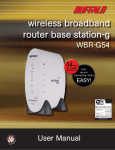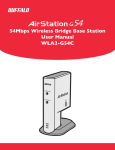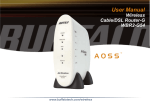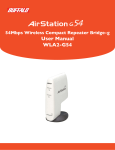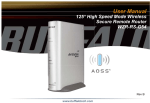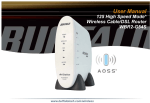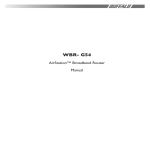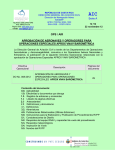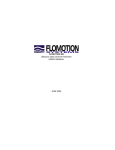Download Buffalo WLA2-G54C User manual
Transcript
wireless compact repeater bridge-g WLA-G54C Interoperable with: Protected AccessTM User Manual i Table of Contents INTRODUCTION . . . . . . . . . . . . . . . . . . . . . . . . . . . . . . . . . . . . . . . 1.1 AirStation 54 Mbps* Compact Repeater Bridge (WLA-G54C) . . . . . . . . . . 1.2 AirStation Wireless Network Features . . . . . . . . . . . . . . . . . . . . . . . . . . . . 1.3 System Requirements . . . . . . . . . . . . . . . . . . . . . . . . . . . . . . . . . . . . . . . . . . 1.4 AirStation Package Contents . . . . . . . . . . . . . . . . . . . . . . . . . . . . . . . . . . . . 1.5 Product Views . . . . . . . . . . . . . . . . . . . . . . . . . . . . . . . . . . . . . . . . . . . . . . . 1.6 About the AirStation CD . . . . . . . . . . . . . . . . . . . . . . . . . . . . . . . . . . . . . . 3 3 3 3 4 4 4 INSTALLATION/SETUP . . . . . . . . . . . . . . . . . . . . . . . . . . . . . . . . . 5 STANDARD SETTINGS . . . . . . . . . . . . . . . . . . . . . . . . . . . . . . . . . 3.1 Introduction . . . . . . . . . . . . . . . . . . . . . . . . . . . . . . . . . . . . . . . . . . . . . . . . . 3.2 Setup Preparation . . . . . . . . . . . . . . . . . . . . . . . . . . . . . . . . . . . . . . . . . . . . 3.3 Setup Overview . . . . . . . . . . . . . . . . . . . . . . . . . . . . . . . . . . . . . . . . . . . . . . 3.4 Access the Web interface . . . . . . . . . . . . . . . . . . . . . . . . . . . . . . . . . . . . . . 3.5 Main Screen. . . . . . . . . . . . . . . . . . . . . . . . . . . . . . . . . . . . . . . . . . . . . . . . . . 3.6 Basic Security . . . . . . . . . . . . . . . . . . . . . . . . . . . . . . . . . . . . . . . . . . . . . . . . 3.7 Basic MAC Address Registration . . . . . . . . . . . . . . . . . . . . . . . . . . . . . . . . . 6 6 6 6 6 7 7 7 ADVANCED CONFIGURATIONS . . . . . . . . . . . . . . . . . . . . . . . . . 8 4.1 LAN Setting. . . . . . . . . . . . . . . . . . . . . . . . . . . . . . . . . . . . . . . . . . . . . . . . . . 8 4.1.1 Wireless . . . . . . . . . . . . . . . . . . . . . . . . . . . . . . . . . . . . . . . . . . . . . . . . . . . 8 4.1.2 LAN Port . . . . . . . . . . . . . . . . . . . . . . . . . . . . . . . . . . . . . . . . . . . . . . . . . 10 4.1.3 Wireless LAN Computer Limitation . . . . . . . . . . . . . . . . . . . . . . . . . . . . 10 4.1.4 WDS . . . . . . . . . . . . . . . . . . . . . . . . . . . . . . . . . . . . . . . . . . . . . . . . . . . . . 10 4.2. Network Settings . . . . . . . . . . . . . . . . . . . . . . . . . . . . . . . . . . . . . . . . . . . 11 4.2.1 Routing Setup (Not in use) . . . . . . . . . . . . . . . . . . . . . . . . . . . . . . . . . . . 11 4.2.2 Packet Filter (Not in use) . . . . . . . . . . . . . . . . . . . . . . . . . . . . . . . . . . . . 11 4.3 Management (Network Diagnosis Settings) . . . . . . . . . . . . . . . . . . . . . . . 11 4.3.1 System Information . . . . . . . . . . . . . . . . . . . . . . . . . . . . . . . . . . . . . . . . . 11 4.3.2 Name/Password . . . . . . . . . . . . . . . . . . . . . . . . . . . . . . . . . . . . . . . . . . . 12 4.3.3 Time Setup . . . . . . . . . . . . . . . . . . . . . . . . . . . . . . . . . . . . . . . . . . . . . . . . 12 4.3.4 Transfer Packet Condition . . . . . . . . . . . . . . . . . . . . . . . . . . . . . . . . . . . 12 4.3.5 PING Test . . . . . . . . . . . . . . . . . . . . . . . . . . . . . . . . . . . . . . . . . . . . . . . . 12 4.3.6 Log Information . . . . . . . . . . . . . . . . . . . . . . . . . . . . . . . . . . . . . . . . . . . 13 4.3.7 Syslog transmitting . . . . . . . . . . . . . . . . . . . . . . . . . . . . . . . . . . . . . . . . . . 13 4.3.8 Save/restore . . . . . . . . . . . . . . . . . . . . . . . . . . . . . . . . . . . . . . . . . . . . . . 13 4.3.9 Initialization/reboot . . . . . . . . . . . . . . . . . . . . . . . . . . . . . . . . . . . . . . . . . 13 4.3.10 Firmware update . . . . . . . . . . . . . . . . . . . . . . . . . . . . . . . . . . . . . . . . . . 14 4.4 Logout . . . . . . . . . . . . . . . . . . . . . . . . . . . . . . . . . . . . . . . . . . . . . . . . . . . . 14 SPECIFICATIONS . . . . . . . . . . . . . . . . . . . . . . . . . . . . . . . . . . . . . 15 TROUBLESHOOTING . . . . . . . . . . . . . . . . . . . . . . . . . . . . . . . . . . 17 GLOSSARY. . . . . . . . . . . . . . . . . . . . . . . . . . . . . . . . . . . . . . . . . . . . 19 FCC INFORMATION . . . . . . . . . . . . . . . . . . . . . . . . . . . . . . . . . . . 21 WARRANTY INFORMATION . . . . . . . . . . . . . . . . . . . . . . . . . . . 22 CONTACT INFORMATION. . . . . . . . . . . . . . . . . . . . . . . . . . . . . . 22 1 Table of Contents 1 Introduction 1.1 AirStation 54 Mbps* Compact Repeater Bridge (WLA-G54C) This User Manual introduces you to the high-speed AirStation 54 Mbps* Compact Repeater Bridge and will assist you with the more advanced features of the product. The AirStation 54 Mbps* Compact Repeater Bridge , WLA-G54C, is a wireless network access point that can be added to an existing network (LAN) to create a wireless network or added to an existing WLAN to extend the range of the WLAN. The WLA-G54C complies with the IEEE 802.11g wireless standard and is interoperable with the IEEE 802.11b wireless standard. IEEE 802.11g technology features longer range than IEEE 802.11a and greater bandwidth with data rates up to 54 Mbps* in the turbo mode. The WLA-G54C supports Wi-Fi Protected Access™, AES, 802.1x and WEP for security. The WLA-G54C supports the Wireless Distribution System (WDS) and can be used as a multi-functional bridge/link between wired and wireless LANs. The WLA-G54C has an MC connector for external antenna support. 1.2 AirStation Wireless Network Features Summary of the AirStation WLA-G54C features: • Wi-Fi™ (Wireless Fidelity) certified AirStation will communicate with other Wi-Fi compliant 802.11g wireless LAN products. • Supports Wi-Fi Protected Access™ (WPA), AES, 802.1x/EAP, and WEP for security • Automatic Transmit Rate Select mechanism transmits at speeds of 24, 12, 11, 5.5, 2 and 1Mbps. • Supports turbo mode of 36, 48 and up to 54 Mbps*. • Wireless Distribution System (WDS) support for multi-point communication. • Ability to set a fixed data rate for faster than 11Mbps ignoring 802.11b legacy devices. • Auto roaming, supports seamless roaming over multiple channels. • Auto VPN setup, for secure communications. • Supports the addition of external 2.4GHz antennas to boost range and performance. • Syslog transmits some or all system activities to a central Syslog server. • Auto Media Dependent Interface/Crossover (MDI/X) port, allows connection by standard and crossover CAT5 cables. • Supports Universal Plug and Play (UPnP). • Improved resistance to environmental conditions. 1.3 System Requirements • Existing Local Area Network • Any Wi-Fi (wireless) compatible computer with a Web Browser Internet Explorer or Netscape 4.5 or later. (Safari 1.0 is supported with Macintosh OS X.2) Buffalo AirStation Client Manager operates on: Windows® 98SE, 2000, Me and XP 2 Introduction 1.4 AirStation Package Contents The AirStation WLA-G54C package contains of the following items: 1. WLA-G54C Compact Repeater Bridge 2. AC adapter and Power cord 3. CAT5 straight cable 4. Quick Setup Guides 5. Utility CD with Manuals 6. Warranty Statement 1.5 Product Views 1.6 About the AirStation CD The AirStation does not require any software to be installed on your computer for configuration.The AirStation CD contains client drivers for Buffalo Wireless Adapters (i.e. Notebook Adapter and Desktop PCI Adapter) and the AirStation Client Manager which can be used to connect the client adapters to the AirStation in order to access the web configuration screen of the AirStation. The WLA-G54C CD contains the AirStation utility,AirNavigator. Buffalo Technology USA does not recommend the use of AirNavigator with the WLA-G54C or any other Buffalo AirStation G54 product. Prior to copying or installing any software, please read the Software License Agreement “license.txt”, located in the root folder of the CD. By installing, copying or using the AirStation software, you are consenting to the terms of this agreement. If you do not agree to all of the terms of the Software License Agreement, do not download, copy or install the AirStation software. It is the policy of Buffalo Technology to improve products as new technology, components, software and firmware become available. Before you proceed with the installation of this product, please consult the AirStation wireless website 3 Introduction 2 Installation/Setup (http://www.buffalotech.com/wireless/) to download and install the latest software for your product. Do not connect the AirStation 54 Mbps* Bridge to your existing network until configuration of the AirStation is complete! Please reference the Quick Setup Guide for information regarding how to connect the AirStation for initial configuration. Once configuration is complete, plug the provided 7ft. Ethernet cable into the 10/100M Ethernet port on the AirStation and plug the other end into an Ethernet port of your existing Local Area Network (LAN). Figure 2.1 Connect to LAN AirStation Compact Repeater Bridge provides wireless connectivity to your existing LAN. Figure 2.1a AirStation in use 4 Introduction 3 Standard Settings 3.1 Introduction Configuring the AirStation using a standard web browser requires basic wireless configuration knowledge. Setup includes manual wireless configuration and basic administrative management. 3.2 Setup Preparation The WLA-G54C is configured to function right out of the box. Basic settings for security and MAC Address registration are offered in this section (3). Specialized setups for security, filtering and other features will be explained in section 4 and configured by clicking the Advanced Button. 3.3 Setup Overview Your computer must be physically connected to the AirStation with an CAT5 straight cable plugged into the LAN port for initial configuration. Refer to the Quick Setup Guide for initial configuration information. A Web browser version 4.5 or later should be used to configure the AirStation. The WLA-G54C CD contains the Client Manager program. The Client Manager is used with a Buffalo Wireless Client Adapter (CardBus, USB or PCI) to associate, setup and configure the AirStation and for monitoring the wireless signal between the AirStation and Buffalo client. Client Manager is currently not recommended for initial configuration of the AirStation. Please refer to the Buffalo website for the latest information and software for the AirStation. Advanced settings for security, filtering and other features will be explained in Section 4. 3.4 Access the Web Interface • Connect the AirStation according to the instructions in the Quick Setup Guide. • The AirStation has a default LAN IP address of 192.168.11.1 and Subnet Mask of 255.255.255.0. ■ Note: The computer used to configure the AirStation must be set to a static IP address of 192.168.11.2 with a subnet mask of 255.255.255.0. The Quick Setup Guide enclosed with the product contains detailed instructions on how to configure your computer for initial configuration. Figure 3.4 Login Window On the computer used to configure the AirStation, launch a Web Browser 4.5 or later. - Enter 192.168.11.1 into the URL field. - A window will open prompting you to enter a User ID and Password. Enter “root” as the User ID and leave the password field blank. 5 Introduction 3.5 Main Screen The main screen is the gateway to all configuration screens of the AirStation. For Advanced settings, click the Advanced button detailed in Section 4. Figure 3.5 Main Setup Screen 3.6 Basic Security Click Encrypt the wireless communications by WEP to enter simple WEP settings to protect your wireless data. Select Encrypt or No encrypt and then select either ASCII or HEX to input a password (encryption code) to encrypt and protect wireless communications. It is possible to enter up to 4 different WEP keys. The WEP key must match between AirStation and clients for secure communications. Examples of WEP keys: Figure 3.6 Basic WEP Setup 64-bit ASCII: 5 digits of alphanumeric characters, “ab34Y” 128-bit ASCII: 13 digits of alphanumeric characters, “123456abcdef7” ■ Note: ASCII WEP is case sensitive. 64-bit HEX: 10 digits, using characters 0-9 and a-f, “00234ABCDE” 128-bit HEX: 26 digits, using characters 0-9 and a-f, “20123456789abcdeabcdeabcde” 3.7 Basic MAC Address Registration Click Register for allowable PC’s MAC address for basic MAC access restriction settings for the AirStation. Input the MAC addresses that are allowed to communicate via the AirStation. Figure 3.7 Basic MAC Address Registration MAC address to be registered - Enter the MAC address of the computers that are allowed to communicate and click register. MAC Addresses should be input in the form of two characters separated by a colon and click Add. MAC Address Ex: 00:00:00:00:00:00 List of PCs found on the Network - Computers connected to the AirStation are shown and can be registered by checking the enable connection checkbox and then clicking Change the marked item. Connection from unregistered wireless PCs Limit - Select Deny and no wireless connection is allowed unless the wireless card’s MAC address is registered with the AirStation. Select Allow and all wireless communication requests are granted. 6 Installation / Setup 4 Advanced Settings Although your AirStation will function fine using only the settings from Section 3, you may wish to explore more advanced options. This chapter explains each parameter. Advanced settings may accessed by clicking the Advanced button on the Main screen. (Section 3.3). Click the Top tab and click the Advanced button. 4.1 LAN SETTING Set up LAN connections. 4.1.1 Wireless Wireless Function - Enable or disable wireless LAN computer communication. Wireless Mode - Select one of the following: •11g(54M)-Turbo - Boosts 11g devices to turbo 54 Mbps* mode. 11b devices cannot connect. •11g(54M)/11b(11M)-Auto - Allows communication of 11g and 11b devices. Communication speed will drop to 11Mbps when 11b devices are connected. (Default setting) •11b(11M) Wi-Fi - Uses only the IEEE 802.11b (11Mbps Wi-Fi compatible) standard. Figure 4.1.1 Wireless LAN Setting ESS-ID (SSID) - Default SSID is the LAN MAC Address of the AirStation.Administrator can alter the SSID of the AirStation by entering an SSID of choice. Use up to 32 alphanumeric characters for the ESS-ID (case sensitive). ■ Note: Roaming - When multiple AirStations have an identical SSID, WEP, client computers may Roam between the AirStations. Wireless Channel - Select the channel used for wireless communication. There are 11 overlapping channels. Channels 1, 6 and 11 are non-overlapping. Default setting is Channel 11. If there are multiple APs in close proximity using the same channel, there may be interference. In this case, change the AirStation channel to another non-overlapping channel. WPA Configuration - Configure WPA (Wi-Fi Protected Access™) setting. Network Authentication is disabled if using WEP. Select 802.1x, WPA or WPA-PSK. WPA Pre-Shared Key - See examples below of examples of a WPA Key. The WPA Group Rekey Interval is an interval of time the encryption keys are changed. Recommended to leave unchanged at “0.” RADIUS Server - Enter the RADIUS Server IP Address RADIUS Port - Enter the RADIUS Server port number RADIUS key is obtained from LAN Administrator (RADIUS Server password) 7 Installation / Setup 802.1x - Uses 802.1x authorization. Clients authorized by RADIUS servers can access this AirStation. RADIUS Server, RADIUS Port and RADIUS Key should be entered.You can also use secure communication selecting WEP encryption from “Type of encryption” field. WPA - Authorized client by RADIUS server can access this AirStation. RADIUS Server, RADIUS Port and RADIUS Key should be entered.You should select either TKIP (Temporal Key Integrity Protocol) or AES (Advanced Encryption Standard) from “Type of encryption” field. WPA-PSK - Clients access this AirStation by PSK (Pre-Shared Key) without RADIUS authorization. You should select either TKIP (Temporal Key Integrity Protocol) or AES (Advanced Encryption Standard) from “Type of encryption” field. Examples of WPA key: WPA-PSK (Pre-Shared Key) must be composed of at least 8 characters, but no more than 63 characters. The following are acceptable characters for a WPA-PSK key: Upper case letters, lower case letters, numbers, spaces, punctuation <>?=+&% WPA-PSK Key Example: “This is <1> example of a WPA Key” ■ Note: WPA keys are case sensitive. Type of Encryption - Select Off, WEP, TKIP or AES Encryption Key (WEP) - If WEP is selected, create and enter an encryption code to protect wireless communications. It is possible to enter up to 4 different WEP keys. The WEP key must match between AirStation and client computers for secure communications. Privacy Separator - Enable or disable communication between wireless clients. If you choose to use this feature, every wireless client that is associated to the AirStation will not be able to communicate with any other wireless clients. ■ Note: If this function is used, wired clients can still communicate with wireless clients. BSS (Basic Service Set) Basic Rate Set - The transmission data rate between devices. If one device supports 2Mbps only, the data rate for the entire network should be limited to 2Mbps (“Default” selection). Otherwise, use 11Mbps Max (“All” selection). Holding 802.11b Association - When this function is enabled, the AirStation requests IEEE802.11b devices to stop communication for a while prior to starting IEEE802.11g communication. If communication speed is decreased, this setting improves total throughput with existing IEEE802.11g and IEEE802.11b standard devices,. The throughput decreases if only IEEE802.11g standard devices exists. DTIM Period - An access point transmits beacon signals to nearby clients at a preset interval. This parameter sets the beacon transmission interval time (1-255 seconds). Selection of a larger number may conserve energy for the client computer (when client power management is enabled), but may delay wireless communication. The default value of 1 is recommended. ■ Note: Setting the DTIM period too high can cause detrimental effects to the network and power saving clients may lose their connections entirely. ANY Connection - Select Allow to accept connections from any wireless client using an SSID of “ANY” and to broadcast the SSID. If Deny is selected under the “ANY Connection,” SSID of the AirStation will not be broadcast and users will not be able to connect to the WLA-G54C unless the specific ESS-ID is entered in the client PC. Wireless output power - Configure output power of AirStation. Decrease wireless output power to shrink the wireless communication range. The default setting of 22mW is recommended. 22mW is combined with the internal 10mW power amplifier to attain 32mW total output. 8 Installation / Setup 4.1.2 LAN port Set LAN side Ethernet settings Figure 4.1.2 LAN Side IP address - Allows administrator to have LAN IP assigned by DHCP Server or specify a static IP and Subnet Mask for the LAN side of the AirStation. LAN Port Setting ■ Note: If the AirStation’s LAN IP address is changed, the configuring computer’s IP must be changed to the same range to continue configuration. If the LAN IP is changed, restart the AirStation. Default Gateway - Allows administrator to use the Default Gateway address (the AirStation’s IP address), assign a specific Gateway address, or block clients from Gateway notification. DNS server - Allows administrator to use the default DNS address (the AirStation’s IP address), assign specific DNS addresses. 4.1.3 Wireless LAN Computer Limitation Figure 4.13 Wireless LAN Computer Limitation MAC Address Registration Wireless LAN Restriction Setup - This option limits the PCs allowed a wireless connection to the AirStation. It is used to control the wireless connections to the AirStation. Register for allowable PC’s MAC address - MAC access restriction set up in LAN. Click to input the MAC addresses to be allowed to communicate. MAC address list - Display a table list of all MAC addresses. Wireless PC’s Connection - Select Limit to restrict the connection and Do not Limit for open access. Register your client PC’s MAC address before selecting Set. Figure 4.1.4 Wireless Bridge (WDS) 4.1.4 Wireless Bridge (WDS) Wireless Distribution System allows the wireless connection of access points to extend a wired or wireless infrastructure to locations where cabling is not possible or too expensive to implement. Wireless bridge (WDS) function: Select Enable to allow WDS mode between AirStations or Disable to block communication between AirStations. Wireless bridge (WDS) dedicated mode: Select Enable to disable wireless PCs from communicating with the AirStation. ■ Note: Both AirStations must supportWDS to communicate with each other.WDS configuration process must be repeated with other bridge access points. Example: AP1 MAC Address is entered into AP2; AP2 MAC Address is entered into AP1; 9 Installation / Setup Add AirStation (MAC Address): Allows administrator to register the wireless MAC address of AirStations for (WDS) point-to-point or point-to multipoint communication between AirStations. The MAC address to enter is found in the Management section, under System Information/Wireless MAC address section. (Section 4.3.1) The WDS function must be set to Enable. The MAC address is 12 characters long. Figure 4.1.5a WDS Display Enter the Wireless MAC address in the form of two characters separated by a colon and click Add. Up to six sets may be registered. MAC Address Example: 00:00:00:00:00:00 Connected AirStation (Display/Delete): Once settings have been added to the WDS configuration screen, the MAC Address of associated Access Point(s) will be displayed. Click Apply to confirm settings. 4.2 NETWORK SETTING 4.2.1 Routing Setup - Routing is not functional feature on an AirStation Bridge. 4.2.2 Packet Filter - Packet Filter is not functional feature on an AirStation Bridge. ■ NOTE: These screens may be skipped entirely. 4.3 MANAGEMENT Network Diagnosis Settings Figure 4.3.1 System Information 10 Installation / Setup 4.3.1 System information System information of the AirStation is obtained here. • Model name - Displays model and firmware version • AirStation Name - Displays AirStation host name • DHCP Server function - Displays On or Off • Wireless - Displays the wireless LAN settings such as wireless MAC address and wireless firmware. • LAN - Displays the AirStation LAN settings • WAN - Displays the AirStation WAN settings • Default Gateway - Displays default gateway settings • WAN side IP address auto acquisition - This is the method to acquire the IP address from the WAN (Internet) side DHCP server. Figure 4.3.2 Name and Password 4.3.2 Name and Password AirStation name - Select a unique name to make it easier to identify each AirStation. Administrator name - “root”, cannot be changed Administrator password - Allows the administrator to enter an administrator password to restrict access to the setting screens. Enter new password. Enter up to eight alphanumeric characters (case sensitive) and confirm password ■ Note: If password is forgotten or misplaced,The WLA-G54C can be returned to all the factory default settings by holding down the INIT button on the back of the unit for three seconds. Figure 4.3.3 Time Setup 4.3.3 Time setup Time setup - Enter the current date and time, and click Set. NTP - Select Use or Do not use. ■ Note: If NTP is used, time is set automatically. NTP server name - Enter the NTP server name Check Interval - Enter the time interval for time check frequency Time Zone - Select local time zone Click Set. Figure 4.3.4 Transfer Packet Information 4.3.4 Transfer Packet Condition Displays number of packets sent and received for: Wired WAN Wired LAN Wireless LAN Click Refresh to start new transfer packet log. Figure 4.3.5 Ping Test 4.3.5 PING Test Performs a PING test from the AirStation to a LAN or WAN address. Enter the target IP address and click OK (e.g. 192.168.11.2 - OR- www.buffalotech.com) 11 Installation / Setup Figure 4.3.7 Log Information 4.3.6 Log Information Display log info level - Select Error and/or Notify to specify the types of reports to be logged by the AirStation. Display log info - Select the specific reports to be logged. Log information - Displays recorded logs. Figure 4.3.7 Syslog Transmitting Figure 4.3.8 Save / Restore Figure 4.3.9 Initialization / Reboot 4.3.7 Syslog transmitting Select Use or Do not use • Syslog Server - Enter the IP address of the Syslog server. • Log Information Level - Select Error and/or Notify to specify the types of reports to be sent to the Syslog server. • Log Information - Select the specific reports to be sent to the Syslog server. 4.3.8 Save/Restore Save current settings - Click Save to open the file saving dialog and save current AirStation settings to a file. Restored saved settings - Restores settings from a file that has been saved. Click Choose file to select the saved file and click Restore. ■ Note: If the setting file is saved by a newer firmware than the current one, the AirStation can’t restore the settings. 4.3.9 Initialization/Reboot Click Restart to reboot AirStation Click Restore to reset the AirStation to default factory settings. ■ Note: Resetting to default factory settings will erase all settings and passwords previously entered. 12 Installation / Setup 4.3.10 Firmware Update Figure 4.3.10 Firmware Update Firmware file name - Enter the path and filename for new firmware or select Browse to search for the path. Click Firmware Update to load firmware to the AirStation. ■ Note: Firmware update does not erase current user settings. ■ Note: Firmware Updates can only be performed by the recommended Web Browsers below on the Macintosh. OSX - The AirStation can be updated using Netscape v7 or Apple’s Safari Web browser v1.0 or later. OS9 - The AirStation can be updated using Netscape v4.5 or later or Internet Explorer 4.5 or later. 4.4 LOGOUT - This feature logs administrator out of the AirStation web interface. Only one user at a time can configure the AirStation with the web interface. ADDITIONAL INFORMATION Please check the Buffalo Web site (www.buffalotech.com/wireless) for the latest information and any corrections made in this manual. For more information, please consult one of the following: • The on-line help system of your AirStation wireless system - for information about software and driver functionality. • The AirStation website at http://www.buffalotech.com - for frequently asked questions (FAQ’s) and Software Updates. 13 Installation / Setup 5 Specifications Physical Specifications Dimensions W2.2 x H4.8 x D3.6in. (W56 x H120 x D92mm) Weight: 9oz (256g with power supply) Temperature & Humidity Operation 0˚ to 40˚ C Humidity: 20-80% (Non condensing) Power Characteristics Transmit Mode 1.1A (Nominal), Power Supply 3.3 V External Antenna Connector - MC Connector Regulatory Information Wireless communication is often subject to local radio regulations. Although AirStation wireless networking products have been designed for operation in the license-free 2.4 GHz band, local radio regulations may impose limitations on the use of wireless communication equipment. Networking Characteristics Compatibility • IEEE 802.11g and 802.11b Standard for Wireless LANs • Wi-Fi (Wireless Fidelity) certified by the Wi-Fi Alliance. Host Operating System Microsoft Windows®) ME/98/NT4.0/2000/XP, Unix/Linux/MacOS Media Access Protocol Wired - CSMA/CD (Collision Detection) Wireless - CSMA/CA (Collision Avoidance) with Acknowledgment (ACK) Radio Characteristics RF Frequency Band 2.4 GHz (2400-2483 MHz) 11 selectable sub-channels Communication Range *Speed Indoor Outdoor 54Mbps 65ft(20m) 165ft(50m) 18Mbps 195ft(60m) 490ft(150m) 11Mbps 245ft(75m) 590ft(180m) 1Mbps 410ft(125m) 1870ft(570m) *All Distances are estimated. Wireless connections may be affected as physical conditions and circumstances vary. Table “Communication Range” lists the typical range when in ordinary use. 14 Installation / Setup Modulation Technique Direct Sequence Spread Spectrum • OFDM • CCK • DQPSK • DBPSK Spreading 11-chip Barker Sequence Bit Error Rate (BER) Better than 10 -5 Nominal Output Power 15 dBm (32mW) Receiver Sensitivity -92 dBm Delay Spread (at FER of <1%) 65 ns 225 ns 400 ns 500 ns • The range of wireless devices can be affected by metal surfaces, solid high-density materials and obstacles in the signal path. ■ Note: The range values listed in Table “Radio Characteristics” are typical distances as measured at Buffalo Technology AirStation laboratories. These values are provided for your guidance but may vary according to the actual radio conditions at the location where the AirStation product is installed. AirStation IEEE 802.11 Channel Sets The range of the wireless signal is related to the Transmit Rate of the wireless communication. Communications at a lower Transmit range may travel longer distances. Center Channel ID FCC 1-2412 4-2427 7-2442 10-2457 2-2417 5-2432 8-2447 11-2462 * 3-2422 6-2437 9-2452 * default channel 15 Troubleshooting 6 Troubleshooting Common Troubleshooting Tips Common Problems: • Out of range, client cannot connect to the AirStation. • Configuration mismatch, client cannot connect to the AirStation. • Absence or conflict with the Client Driver. • Conflict of another device with the AirStation hardware. 1.1 LED Activity Monitoring LED activity helps identify problems. • Wireless LED should be GREEN if the line is active. If is it blinking GREEN, wireless communication is active. • Ethernet LED should be GREEN (100Mbps) or AMBER (10Mbps) while the communication is active. If the LEDs indicate that the network is working properly (Transmit/Receive LED blinks), check the TCP/IP settings of the network. 1.2 LEDs Work But Client PC Cannot Connect to Network If the LEDs indicate that the network is working properly (Wireless LED is on, Transmit/Receive LED blinks), check the TCP/IP settings of the network. Changing Client TCP/IP Settings in your computer. Consult the LAN Administrator for TCP/IP settings. Windows To add or change the TCP/IP Settings: 1. On the Windows task bar click Start. 2. Select Settings, then Control Panel. 3. Double-click on the Network icon to view the Network Properties. 4. From the list of installed components, verify the TCP/IP -> Buffalo Wireless LAN adapter protocol (or appropriate wireless LAN adapter) is installed. • If this protocol is not yet installed, click the Add button and select the TCP/IP protocol from the list. Refer to Windows Help for more information. • If this protocol is installed, select this protocol and click the Properties button. Verify the parameters match the settings provided by your LAN Administrator. Make changes if necessary, and click OK. 5. When prompted, restart your computer. 16 Troubleshooting Macintosh OS X 1. Open the System Preferences from your Dock 2. Click Network 3. Select Airport under Show 4. Select DHCP or input static IP Address The AirStation 54 Mbps* Wireless Notebook Adapter,WLI-CB-G54A, works with Powerbooks and the AirStation Wireless Desktop PCI Adapter, WLI-PCI-G54 works with PowerMac Desktops. Users must have OS 10.2.6 and Airport 3.1 or 3.1.1 Macintosh OS9 1. Open the Control Panels 2. Double-click TCP/IP 3. Select Airport 4. Select DHCP or input static IP Address Buffalo does not have an 54 Mbps* 802.11g solution for OS 9. 1.3 Other Problems Please refer to www.buffalotech.com for further reference materials or call Buffalo’s Toll-Free Tech Support 24 hours a day, 7 days a week at 866-752-6210. 1.3 Other Problems Please refer to www.buffalotech.com for further reference materials. 17 Specifications 7 Glossary 10BaseT or 100BaseTx: 802.3 based Ethernet network that uses UTP (Unshielded twisted pair) cable and a star topology. 10 is 10 Mbps and 100 is 100 Mbps. 802.1x: The standard for wireless LAN authentication used between an AP and a client. 802.1x with EAP will initiate key handling. Ad-Hoc Network: The wireless network based on a peer-to-peer communications session. Also referred to as AdHoc. Bandwidth: The transmission capacity of a computer or a communication channel, stated in Megabits per second (Mbps). BSS (Basic Service Set): An 802.11 networking framework that includes an Access Point. Client: A PC or workstation on a network. Cross-Over Wiring: A UTP cable that has its transmit and receive pair crossed to allow communications between two devices. DCE (Data Communications Equipment): Hardware used for communication with a Data Terminal Equipment (DTE) device. Default Gateway: The IP Address of either the nearest router or server for the LAN. DHCP (Dynamic Host Configuration Protocol): Based on BOOTP, it uses a pool of IP addresses, which it assigns to each device connected to it, and retrieves the address when the device becomes dormant for a period of time. DNS (Domain Name System): System used to map readable machine names into IP addresses Driver: Software that interfaces a computer with a specific hardware device. DSSS (Direct Sequence Spread Spectrum): Method of spreading a wireless signal into wide frequency bandwidth. 18 Specifications Ethernet cable: A wire similar to telephone cable that carries signals between Ethernet devices. Firmware: Programming inserted into programmable read-only memory, thus becoming a permanent part of a computing device. Frame: A fixed block of data, transmitted as a single entity. Also referred to as packet. Full-Duplex: To transmit on the same channel in both directions simultaneously. Gbps (Giga Bits per second): One billion bits per second. Half-duplex: To transmit on the same channel in both directions, one direction at a time. Hub: A device which allows connection of computers and other devices to form a LAN. IEEE (Institute of Electrical and Electronics Engineers): The professional organization which promotes development of electronics technology. IP (Internet Protocol) Address: A unique 32-binary-digit number that identifies each sender or receiver of information sent in packets. Infrastructure: A wireless network or other small network in which the wireless network devices are made a part of the network through the Access Point. ISP (Internet Service Provider): A company that provides access to the Internet and other related services. IV (Initialization Vector): The header section of a message packet. LAN (Local Area Network): A group of computers and peripheral devices connected to share resources. LED (Light Emitting Diode): The lights on a hardware device representing the activity through the ports. MAC (Medium Access Control) Address: A unique number that distinguishes network cards. DTE (Data Terminal Equipment): Device that controls data flowing to and from a computer. Mbps (Mega Bits Per Second): A measurement of millions of bits per second. Dynamic IP Address: An IP address that is automatically assigned to a client station in a TCP/IP network, typically by a DHCP server. MDI/X (Media Dependent Interface/Cross-over): Port on a network hub or switch that crosses the incoming transmit lines with the outgoing receive lines. ESS (Extended Service Set): A set of two or more BSSs that form a single sub-network. ESS-ID is user identification used in the ESS LAN configuration. MHz (MegaHertz): One million cycles per second. Ethernet: The most widely used architecture for Local Area Networks (LANs). It is a shared-media network architecture. The IEEE 802.3 standard details its functionality. NAT (Network Address Translation): An internet standard that enables a LAN to use one set of IP addresses for internal traffic and a second set for external traffic. MIB II: A database containing performance information and statistics on each device in a network. NIC (Network Interface Card): An expansion card connected to a computer so the computer can be connected to a network. Packet: A block of data that is transferred as a single unit, also called a frame or a block. Packet Filtering: Discarding unwanted network traffic based on its originating address or its type. PCI (Peripheral Component Interconnect): A bus that is connected directly to the CPU. PCMCIA (Personal Computer Memory Card International Association) Card: Removable module that adds features to a portable computer. Ping (Packet Internet Groper): An Internet utility used to determine whether a particular IP address is online. Plug and Play: Hardware that, once installed (“plugged in”), can immediately be used (“played”), as opposed to hardware that requires manual configuration. PoE (Power over Ethernet): A mechanism to send DC power to a device using a CAT5 Ethernet cable. PPPoE (Point-to-Point Protocol over Ethernet): A specification for connecting users on an Ethernet line to the Internet through a common broadband medium. RADIUS (Remote Authentication Dial In User Service): A server that issues authentication key to clients. Repeater Hub: A device that collects, strengthens and transmits information to all connected devices, allowing the network to be extended to accommodate additional workstations. TFTP (Trivial File Transfer Protocol): Simple form of FTP (File Transfer Protocol), which Uses UDP (User Datagram Protocol), rather than TCP/IP for data transport and provides no security features. TKIP (Temporal Key Integrity Protocol): An encryption method replacing WEP. TKIP uses random IV and frequent key exchanges. Topology: The shape of a LAN (Local Area Network) or other communications system. Twisted Pair: Cable that comprises 2 or more pair of insulated wires twisted together. UDP (User Datagram Protocol): A communication method (protocol) that offers a limited amount of service when messages are exchanged between computers in a network. UDP is used as an alternative to TCP/IP. Uplink: Link to the next level up in a communication hierarchy. UTP (Unshielded Twisted Pair) cable: Two or more unshielded wires twisted together to form a cable. WAN (Wide Area Network): A networking system covering a wide geographical area. WEP (Wired Equivalent Privacy): An encryption method based on 64 or 128-bit algorithm. Web Browser: A software program that allows viewing of web pages. RJ-45 connector: An 8-pin connector used between a twisted pair cable and a data transmission device. Wi-Fi (Wireless Fidelity): An organization that tests and assures interoperability among WLAN devices. Router: Device that can connect individual LANs and remote sites to a server. Wire Speed: The maximum speed at which a given packet can be transferred using Ethernet and Fast Ethernet standard specifications. Script: A macro or batch file containing instructions and used by a computer to perform a task. Server: Any computer that makes files or peripheral devices available to users of the network and has a resident Network OS. SMTP (Simple Mail Transfer Protocol): The protocol used to define and deliver electronic mail (E-mail) from one location to another. SNMP (Simple Network Management Protocol: An application layer protocol that outlines the formal structure for communication among network devices. Static IP Address: A permanent IP address is assigned to a node in a TCP/IP network. Also known as global IP. STP (Shielded Twisted Pair): Twisted Pair cable wrapped in a metal sheath to provide extra protection from external interfering signals. Subnet Mask: An eight-byte address divided into 4 parts Specifications TCP/IP (Transmission Control Protocol/Internet Protocol: Protocol used by computers when communicating across the Internet or Intranet. RC4: The encryption algorithm that is used in WEP. Roaming: The ability to use a wireless device while moving from one access point to another without losing the connection. 19 separated by periods. WLAN (Wireless LAN): A LAN topology using wireless devices. VPN (Virtual Private Network): A security method to connect remote LAN users to a corporate LAN system. 8 FCC / CE Information Federal Communication Commission Interference Statement This equipment has been tested and found to comply with the limits for a Class B digital device, pursuant to Part 15 of the FCC Rules. These limits are designed to provide reasonable protection against harmful interference in a residential installation. This equipment generates, uses and can radiate radio frequency energy and, if not installed and used in accordance with the instructions, may cause harmful interference to radio communications. However, there is no guarantee that interference will not occur in a particular installation. If this equipment does cause harmful interference to radio or television reception, which can be determined by turning the equipment off and on, the user is encouraged to try to correct the interference by one of the following measures: • Re-orient or relocate the receiving antenna. • Increase the separation between the equipment and receiver. • Connect the equipment into an outlet on a circuit different from that to which the receiver is connected. • Consult the dealer or an experienced radio/TV technician for help. FCC Caution:To assure continued compliance, (example - use only shielded interface cables when connecting to computer or peripheral devices). Any changes or modifications not expressly approved by the party responsible for compliance could void the user’s authority to operate this equipment. This device complies with Part 15 of the FCC Rules. Operation is subject to the following two conditions: (1) This device may not cause harmful interference, and (2) this device must accept any interference received, including interference that may cause undesired operation. IMPORTANT NOTE: FCC RF Radiation Exposure Statement: This equipment complies with FCC RF radiation exposure limits set forth for an uncontrolled environment.This equipment should be installed and operated with a minimum distance of 20 centimeters between the radiator and your body. This transmitter must not be co-located or operating in conjunction with any other antenna or transmitter. R&TTE Compliance Statement This equipment complies with all the requirements of the DIRECTIVE 1999/5/EC OF THE EUROPEAN PARLIAMENT AND THE COUNCIL of 9 March 1999 on radio equipment and telecommunication terminal Equipment and the mutual recognition of their conformity (R&TTE). The R&TTE Directive repeals and replaces in the directive 98/13/EEC (Telecommunications Terminal Equipment and Satellite Earth Station Equipment) As of April 8, 2000. Safety This equipment is designed with the utmost care for the safety of those who install and use it. However, special attention must be paid to the dangers of electric shock and static electricity when working with electrical equipment. All guidelines of this manual and of the computer manufacturer must therefore be allowed at all times to ensure the safe use of the equipment. EU Countries intended for use The ETSI version of this device is intended for home and office use in Austria, Belgium, Denmark, Finland, France (with Frequency channel restrictions), Germany, Greece, Iceland, Ireland, Italy, Luxembourg, Norway, The Netherlands, Portugal, Spain, Sweden, Switzerland and United Kingdom. The ETSI version of this device is also authorized for use in EFTA member states Iceland, Liechtenstein, Norway and Switzerland. EU Countries Not intended for use None Potential restrictive use France: Only channels 10,11,12, and 13. 20 FCC / CE Information 9 Warranty Information Buffalo Technology (Melco Inc.) products come with a two-year limited warranty from the date of purchase. Buffalo Technology (Melco Inc.) warrants to the original purchaser the product; good operating condition for the warranty period. This warranty does not include non-Buffalo Technology (Melco Inc.) installed components. If the Buffalo product malfunctions during the warranty period, Buffalo Technology/ (Melco Inc.) will, replace the unit, provided the unit has not been subjected to misuse, abuse, or non-Buffalo Technology/(Melco Inc.) authorized alteration, modifications or repair. All expressed and implied warranties for the Buffalo Technology (Melco Inc) product line including, but not limited to, the warranties of merchantability and fitness of a particular purpose are limited in duration to the above period. Under no circumstances shall Buffalo Technology/(Melco Inc.) be liable in any way to the user for damages, including any lost profits, lost savings or other incidental or consequential damages arising out of the use of, or inability to use the Buffalo products. In no event shall Buffalo Technology/(Melco Inc.) liability exceed the price paid for the product from direct, indirect, special, incidental, or consequential damages resulting from the use of the product, its accompanying software, or its documentation. Buffalo Technology/(Melco Inc.) does not offer refunds for any product. © 2003 Buffalo Technology (Melco, Inc.) 10 Contact Information ADDRESS Buffalo Technology (USA), Inc. 4030 West Braker Lane, Suite 120 Austin, TX 78759-5319 GENERAL INQUIRIES Monday through Friday 8:30am-5:30pm CT Direct: 512-794-8533 Toll-free: 800-456-9799 Fax: 512-794-8520 Email: [email protected] TECHNICAL SUPPORT North American Technical Support by phone is available 24 hours a day, 7 days a week. (USA and Canada). Toll-free: (866) 752-6210 Email: [email protected] *54 Mbps is the IEEE 802.11g standard theoretical maximum data transfer rate. Actual wireless network throughput is limited by environmental and system factors and will be less. 21 Warranty Information






















